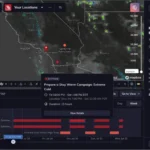This originally appeared on CNBC in May 2023.
KEY POINTS
Tomorrow.io recently launched Tomorrow-R1, the world’s first commercially built weather-radar satellite, via SpaceX’s Falcon 9 rocket.
Boston-based Tomorrow.io began as a software company that offered hyper-precise, street-level weather forecasting. Now it has set its sights on space.
The company recently launched Tomorrow-R1, what it claims is the world’s first commercially built weather-radar satellite, via SpaceX’s Falcon 9 rocket. There are very few atmospheric radars orbiting the Earth currently, and all were built by government agencies. The U.S. has one, operated by NASA.
Tomorrow.io used proprietary software not just to predict but also to help companies plan for severe weather. The information it used came from government radar, data satellites, weather stations, cellular signal attenuation, and even connected vehicles with wiper and temperature sensors — what its CEO and co-founder, Shimon Elkabetz, called the “weather of things.”
The new radar satellite, however, will offer a much broader scope of data.
“We’re going to create a significant revolution when it comes to weather forecasting and climate modeling and be able to help the National Hurricane Center hopefully have better hurricane forecasting and help insurance companies insure farmers in India and Brazil, and help airlines fly from JFK to London in a much safer route and by wasting less fuel,” said Elkabetz.
The NASA radar satellite has a lag time of three days or more for its information, simply due to distance and how often it passes over the U.S. Local ground radar, which is what Americans usually see on the local news, is not available in all locations. In fact, most of Latin America, Africa, the Middle East, India, and many other places lack radar coverage. Moreover, land-based radar doesn’t cover specific mountainous regions in the U.S., nor does it extend over the ocean. That makes it harder for coastal regions to get accurate storm predictions.
Satellites could provide coverage to billions more people.
Elkabetz said the company intends to launch more than two dozen of its own satellites over the next two years. In combination with sensor microwave technology, he says this will create a ‘constellation’ of weather monitoring systems that will be able to sample every point on earth, nearly every hour.
“We’re putting our own designed and manufactured radar on a dedicated satellite, and we’re putting many of these out there in a combination with another sensor microwave sounder that is going to put be put on another satellite,” he explained. “The combination of the two together will create a global real-time precipitation map that will basically cover every point on Earth in close to real-time.”
Major clients now include several airlines, such as Delta, United, and Jetblue. In a case study done in 2021, JetBlue found that Tomorrow.io let it understand when a storm would stop, helping it limit unnecessary delays and cancellations, saving its operations team as much as $50,000 per month per hub.
Other clients include Fox Sports, Uber, Google Cloud, Amazon Web Services, Microsoft, and the U.S. Air Force.
Tomorrow.io has been awarded more than $20 million in U.S. Defense Department contracts and is executing a collaborative research and development agreement with National Oceanic and Atmospheric Administration, according to a press release.
See Weather Intelligence






